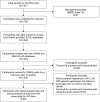Out-of-pocket costs and adherence to antihypertensive agents among older adults covered by the public drug insurance plan in Quebec
- PMID: 28932106
- PMCID: PMC5598752
- DOI: 10.2147/PPA.S138364
Out-of-pocket costs and adherence to antihypertensive agents among older adults covered by the public drug insurance plan in Quebec
Abstract
Objective: To evaluate the effect of patient out-of-pocket costs on adherence to antihypertensive agents (AHA) in community-dwelling older adults covered by the public drug insurance plan in Quebec.
Methods: This is a secondary analysis of data from the "Étude sur la santé des aînés" study (2005-2008) on community-dwelling older adults in Quebec aged 65 years and older (N=2,811). The final sample included 881 participants diagnosed with arterial hypertension and treated with AHA. Medication adherence was measured with the proportion of days covered over a 2-year follow-up period (<80% and ≥80%). Out-of-pocket costs for AHA, in Canadian dollars (CAD), at cohort entry were categorized as follows: $0, $0.01-$5.00, $5.01-$10.00, $10.01-$15.00 and $15.01-$36.00. Multivariable logistic regression models were constructed to study adherence to AHA as a function of out-of-pocket costs while controlling for several confounders. Models were also stratified by annual household income (<$15,000 CAD and ≥$15,000 CAD).
Results: In this study, 80.8% of participants were adherent to their AHA. Among participants reporting an annual household income <$15,000 CAD, those with an out-of-pocket cost of $10.01-$15.00 CAD were significantly less adherent to their AHA than those with no contribution (OR =0.175, 95% CI: 0.042-0.740). Among participants reporting an income of ≥$15,000 CAD, those with out-of-pocket costs of $0.01-$5.00 CAD (OR =0.194; 95% CI: 0.048-0.787), $5.01-$10.00 CAD (OR =0.146; 95% CI: 0.036-0.589), $10.01-$15.00 CAD (OR =0.192; 95% CI: 0.047-0.777) and $15.01-$36.00 CAD (OR =0.160, 95% CI: 0.039-0.655) were significantly less adherent to their AHA than participants with no contribution.
Conclusion: Increased out-of-pocket costs are associated with non-adherence to AHA in older adults covered by a public drug insurance plan, more importantly in those reporting an annual household income ≥$15,000 CAD. A reduction in the amount of out-of-pocket costs and yearly maximum contribution for drugs may improve adherence to treatment.
Keywords: hypertension; income; medication adherence; out-of-pocket costs; seniors.
Conflict of interest statement
Disclosure HMV is a Senior research scholar with the FRQS. RM received a scholarship from the Faculty of Medicine and Health Sciences of Université de Sherbrooke. SGG holds a Doctoral Award – Frederick Banting and Charles Best Canada Graduate Scholarships (CGS–D) from CIHR (number: 146258). The authors report no other conflicts of interest in this work.
Figures


Similar articles
-
Impact of drug plans on adherence to and the cost of antihypertensive medications among patients covered by a universal drug insurance program.Can J Cardiol. 2014 May;30(5):560-7. doi: 10.1016/j.cjca.2013.11.032. Epub 2013 Dec 10. Can J Cardiol. 2014. PMID: 24613090
-
Association between depressive and anxiety disorders and adherence to antihypertensive medication in community-living elderly adults.J Am Geriatr Soc. 2012 Dec;60(12):2297-301. doi: 10.1111/j.1532-5415.2012.04239.x. Epub 2012 Oct 30. J Am Geriatr Soc. 2012. PMID: 23110563
-
Does increased adherence to medications change health care financial burdens for adults with diabetes?J Diabetes. 2015 Nov;7(6):872-80. doi: 10.1111/1753-0407.12292. Epub 2015 May 6. J Diabetes. 2015. PMID: 25817601
-
The association between side effects and adherence to antidepressants among primary care community-dwelling older adults.Aging Ment Health. 2020 Aug;24(8):1229-1236. doi: 10.1080/13607863.2019.1594165. Epub 2019 Apr 2. Aging Ment Health. 2020. PMID: 30938182
-
Adherence to Oral Antihyperglycemic Agents Among Older Adults With Mental Disorders and Its Effect on Health Care Costs, Quebec, Canada, 2005-2008.Prev Chronic Dis. 2015 Dec 31;12:E230. doi: 10.5888/pcd12.150412. Prev Chronic Dis. 2015. PMID: 26719900 Free PMC article.
Cited by
-
Knowledge, attitude, behaviour, and influencing factors of home-based medication safety among community-dwelling older adults with chronic diseases: a cross-sectional study.BMC Geriatr. 2023 Apr 28;23(1):256. doi: 10.1186/s12877-023-03966-3. BMC Geriatr. 2023. PMID: 37118686 Free PMC article.
-
Out-of-pocket expenditure for hypertension care: a population-based study in low-income urban Medellin, Colombia.Glob Health Action. 2020 Dec 31;13(1):1806527. doi: 10.1080/16549716.2020.1806527. Glob Health Action. 2020. PMID: 32867605 Free PMC article.
-
Assessment of the utilization of real-time prescription benefits for patient cost savings within an outpatient setting.Explor Res Clin Soc Pharm. 2024 Jun 5;14:100460. doi: 10.1016/j.rcsop.2024.100460. eCollection 2024 Jun. Explor Res Clin Soc Pharm. 2024. PMID: 38974055 Free PMC article.
-
A global perspective on the costs of hypertension: a systematic review.Arch Med Sci. 2020 Jan 31;16(5):1078-1091. doi: 10.5114/aoms.2020.92689. eCollection 2020. Arch Med Sci. 2020. PMID: 32863997 Free PMC article. Review.
-
We need to mandate drug cost transparency on electronic medical records.CMAJ. 2017 Dec 18;189(50):E1541-E1542. doi: 10.1503/cmaj.171070. CMAJ. 2017. PMID: 29255097 Free PMC article. No abstract available.
References
-
- Statistics Canada The 10 leading causes of death. 2011. [Accessed February 9, 2017]. Available from: http://www.statcan.gc.ca/pub/82-625-x/2014001/article/11896-eng.htm.
-
- Public Health Agency of Canada Report from the Canadian Chronic Disease Surveillance System: Hypertension in Canada. 2010. [Accessed February 9, 2017]. Available from: http://www.phac-aspc.gc.ca/cd-mc/cvd-mcv/ccdss-snsmc-2010/pdf/CCDSS_HTN_....
-
- Ho PM, Bryson CL, Rumsfeld JS. Medication adherence: its importance in cardiovascular outcomes. Circulation. 2009;119(23):3028–3035. - PubMed
-
- Savage PJ, Pressel SL, Curb JD, et al. Influence of long-term, low-dose, diuretic-based, antihypertensive therapy on glucose, lipid, uric acid, and potassium levels in older men and women with isolated systolic hypertension: The Systolic Hypertension in the Elderly Program. SHEP Cooperative Research Group. Arch Intern Med. 1998;158(7):741–751. - PubMed
LinkOut - more resources
Full Text Sources
Other Literature Sources
Miscellaneous

